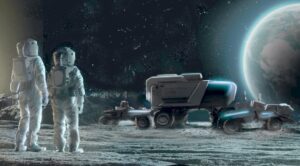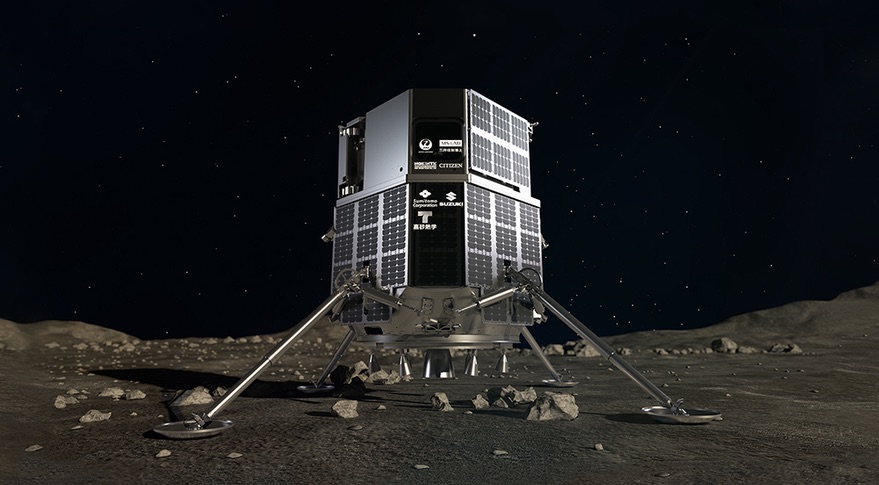Companies and government agencies announce plans for lunar rover projects
By Jeff Foust

WASHINGTON — The Japanese and Canadian space agencies announced plans May 26 to send small rovers to the moon in the next several years, as Lockheed Martin unveiled a partnership with automaker General Motors to propose a rover for NASA’s Artemis program.
The Japanese space agency JAXA said it is working with several Japanese companies to fly a tiny rover on a lunar lander mission to launched in 2022 by ispace. The rover, roughly the size of a baseball, will split in half after landing, with the two hemispheres serving as wheels. It will move on the surface to collect data on autonomous driving technology to aid in the development of future rovers, including a large pressurized rover that JAXA is designing in cooperation with Toyota.
The rover is one of several payloads that ispace is carrying to the moon on its first lunar lander, called Mission 1, launching in 2022. The lander is carrying another rover, called Rashid, being developed by the Mohammed Bin Rashid Space Center in the United Arab Emirates under a deal announced in April.
In a call with reporters, Takeshi Hakamada, chief executive of the Tokyo-based company, said the JAXA deal now means the payload space on the Mission 1 lander is full. The lander itself is being assembled and tested in an ArianeGroup facility in Germany. The lander will launch on a SpaceX Falcon 9 in 2022. “We are very confident we will meet this schedule,” he said.
Mission 1, as the name suggests, is the first in a series of lunar lander missions ispace is proposing to fly. “The commercial lunar transportation business has started,” he said. “I’m proud that we’re supporting many customers.”

Canadian plans
Among those customers for ispace’s Mission 1 are three Canadian companies that will fly instruments or collect data on the lander mission with the support of awards by the Canadian Space Agency (CSA) announced May 26.
Mission Control Space Services will fly a computer on the lander to test artificial intelligence algorithms that will be used to support operations of the Rashid rover. Canadensys Aerospace Corporation is providing a camera capable of taking 360-degree images. NGC Aerospace Ltd. will test a navigation system that will take images of the moon from orbit and compare them to maps to provide a precise location.
While each company received funding from CSA for their payloads, the companies arranged for payload space independently on ispace’s Mission 1 lander. Hakamada said that he believes the companies all chose ispace based on its technology and business model.
“Mission Control is confident in their ability to execute this cutting-edge mission and in doing so help us demonstrate state of the art technology for operating lunar rovers,” Ewan Reid, president and chief executive of Mission Control Space Services, said of ispace in a statement.
CSA highlighted those three payloads during a separate briefing May 26 as part of a broader discussion of the agency’s lunar plans. That includes contributing the Canadarm3 robotic arm for NASA’s lunar Gateway, and in return getting to fly a Canadian astronaut on the Artemis 2 mission around the moon and a later mission to the Gateway.
The agency is proceeding with plans discussed last year to fly a small rover on a future robotic lunar lander. The rover will carry two instruments, one Canadian and one American, and is designed to operate for at least one lunar day and, if it can survive the 14-day lunar night, a second lunar day.
CSA President Lisa Campbell said the agency will soon release a request for proposals for the rover, and will select two companies for initial design and development work before choosing one of them to build the rover.
The agency didn’t discuss launch plans for the rover at the event, but officials previously said it would fly on a commercial lander through NASA’s Commercial Lunar Payload Services program in the next five years. “The timeline is as aggressive as ever,” she said.
Lockheed and GM join forces
While Canada and Japan make plans to fly small robotic rovers, Lockheed Martin announced May 26 a partnership with General Motors to work on the design of a rover intended to carry astronauts on Artemis missions.
Lockheed executives said they decided to work with one of the world’s largest automakers to leverage technologies it is developing for terrestrial vehicles for use on rovers designed to be more capable than the rovers used on the final three Apollo missions a half-century ago.
“In order to have a sustained presence at the moon, we’re going to need mobility,” Lisa Callahan, vice president and general manager of Commercial Civil Space at Lockheed, said in an online event about the partnership. “GM is making billions of dollars of investments in battery technology and autonomy. We’re really excited about this partnership, pairing that with our expertise in building deep-space robotic and human spacecraft.”
GM executives said they were interested in novel application of technologies they’re developing for conventional automobiles. “For folks at GM, if you’re a vehicle engineer and you have the opportunity to work on the lunar vehicle, this is pretty much a dream come true,” said Jeff Ryder, vice president of growth and strategy for General Motors Defense, the GM subsidiary that works on government programs.
While the companies showed illustrations of a rover capable of carrying two astronauts, the companies revealed few technical details about the design, nor disclosed how much money that had invested so far on the project. “We’re still very much in the early stages of shaping this,” Ryder said.
One reason for the lack of details is that the companies are waiting on NASA to release a request for proposals to develop a lunar rover. That RFP is expected in the second half of this year, Ryder said, and the companies will use the requirements the agency includes in it to refine its design and seek funding for it.
“We’re looking not only at the requirements that we anticipate from NASA, but also other areas of the lunar economy we think we can satisfy with the rover,” said Kirk Shireman, vice president of lunar exploration campaigns at Lockheed Martin. “We’re in the process of dreaming big and converging to what we think the requirements set will be. It’s a really, really fun time for the project.”
May 28, 2021 at 05:05AM
via SpaceNews read more...

Post a Comment